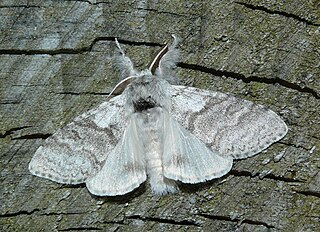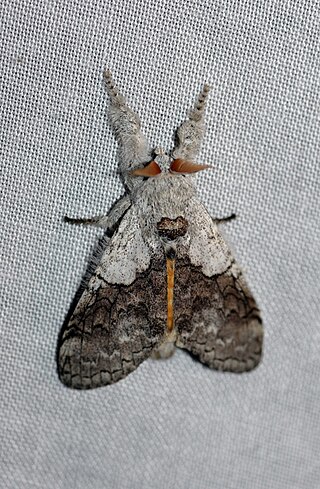
Hylobius abietis or the large pine weevil is a beetle belonging to family Curculionidae. This species is widely regarded as the most important pest of most commercially important coniferous trees in European plantations. Seedlings planted or arising from natural regeneration after clear felling operations are especially at risk. The adult weevils cause damage by eating the bark of seedlings around the 'collar' of the stem, thus 'ring-barking' the tree seedling which usually results in its demise.

Digama is a genus of moths in the family Erebidae described by Frederic Moore in 1858. It is distributed in South Africa, China, throughout India, Sri Lanka, Myanmar and Australia.

Calliteara pudibunda, the pale tussock, is a moth of the family Erebidae. The Dutch common name for the moth (Meriansborstel) comes from the butterfly and insect painter Maria Sibylla Merian. The species was first described by Carl Linnaeus in his 1758 10th edition of Systema Naturae. It is found in Asia and Europe.
Chamyna is a genus of moths of the family Erebidae. The genus was erected by Jacob Hübner in 1821.

Calliteara is a genus of tussock moths in the family Erebidae. The genus was erected by Arthur Gardiner Butler in 1881.

The Pineapple gall adelgid is a type of conifer-feeding insect that forms pineapple-shaped plant galls on its host species, commonly Norway and Sitka spruce. The adelgids are pear-shaped, soft-bodied green insects with long antennae, closely related to the aphid. Adelges lays up to one hundred eggs at a time, one on each needle. Adelges abietis is one of the most common species; synonyms are A. gallarum-abietis, Chermes abietis and Sacciphantes abietis.

Calliteara farenoides is a species of moth of the family Erebidae. It is found in Queensland.

Calliteara lunulata is a moth of the family Erebidae. It is found in the Russian Far East, Japan, China and Taiwan.

Calliteara arizana is a moth of the family Erebidae first described by Alfred Ernest Wileman in 1910. It is found in Taiwan.
Calliteara albibasalis is a moth of the family Erebidae first described by William Jacob Holland in 1893. It is found in Gabon.

Calliteara baibarana is a moth of the subfamily Lymantriinae first described by Shōnen Matsumura in 1927. It is found in Taiwan.

Synanthedon loranthi is a moth of the family Sesiidae. It is found in most of Europe and Asia Minor.

Calliteara fortunata is a moth of the family Erebidae first described by Alois Friedrich Rogenhofer in 1891. It is found on the Canary Islands.

Calliteara strigata is a moth of the family Erebidae first described by Frederic Moore in 1879.
Calliteara flavobrunnea is a moth of the family Erebidae. It was described by Robinson in 1969. It is found on Fiji.

The Orgyiini are a tribe of tussock moths of the family Erebidae. The tribe was described by Wallengren in 1861.

Calliteara horsfieldii, or Horsfield's tussock moth, is a moth of the family Erebidae. The species was first described by the British entomologist Edward Saunders in 1851, and named in honor of the British naturalist Thomas Horsfield, who traveled southern Asia and published works on zoology from the region. C. horsfieldii can be found in southern Asia, the islands of the northern Indian Ocean, and many parts of south east Asia and Indonesia. It is also sometimes referred to as the Yellow Tussock Moth.

Dryocoetes is a genus of beetles belonging to the family Curculionidae.
This page is based on this
Wikipedia article Text is available under the
CC BY-SA 4.0 license; additional terms may apply.
Images, videos and audio are available under their respective licenses.















